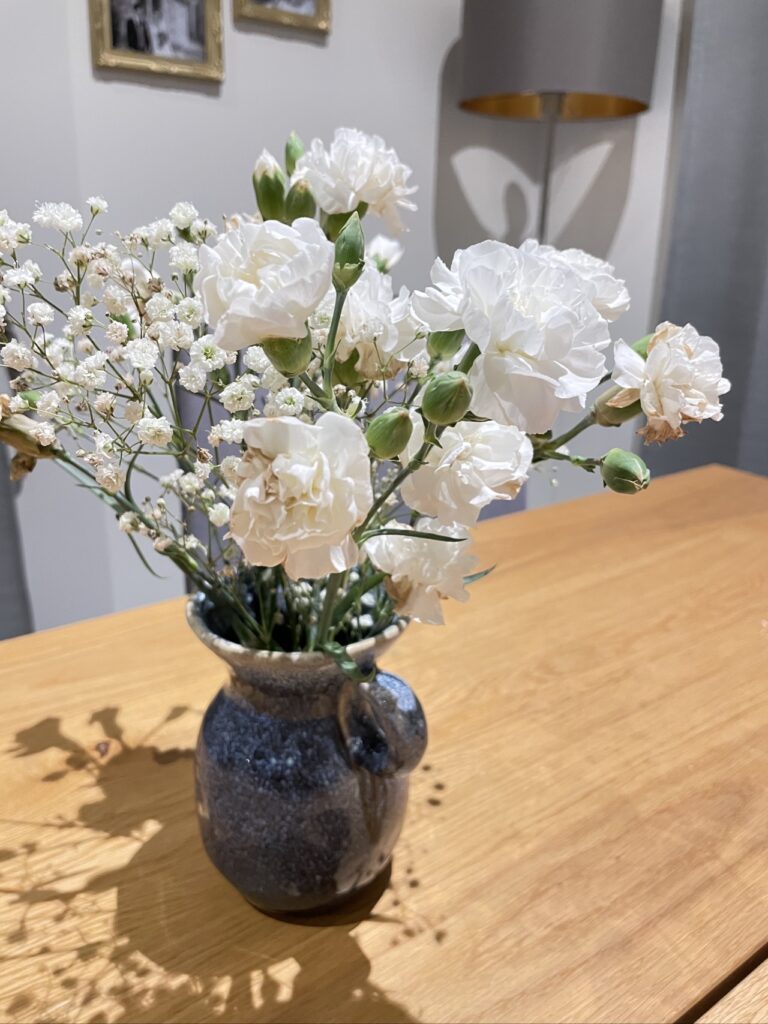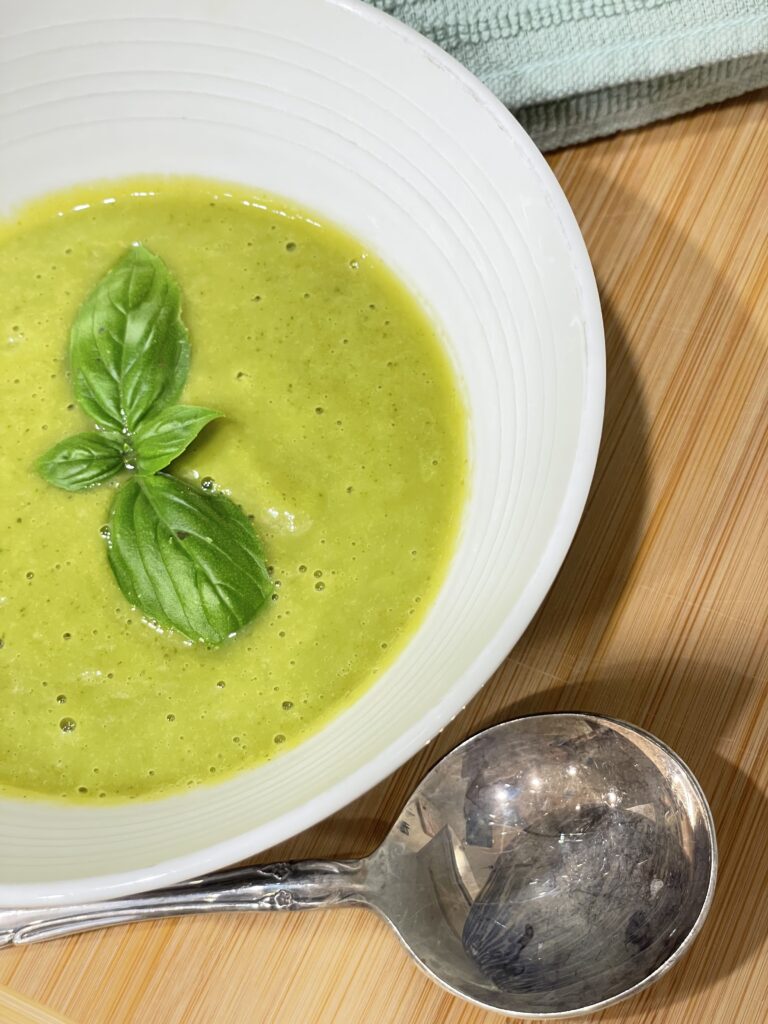How to clean a black kitchen sink: Composite sinks
Black kitchen sinks are a stunning addition to any home. They’re sleek, modern, and bring a sense of sophistication that elevates the whole kitchen. But if you own one, you probably know they can be a bit of a double-edged sword. While they’re excellent at hiding stains and smudges that are glaringly obvious on stainless steel or white porcelain, they’re notorious for showing hard water spots, soap scum, and buildup. Trust me, I’ve been there. So how to clean a black kitchen sink? Let’s find out.
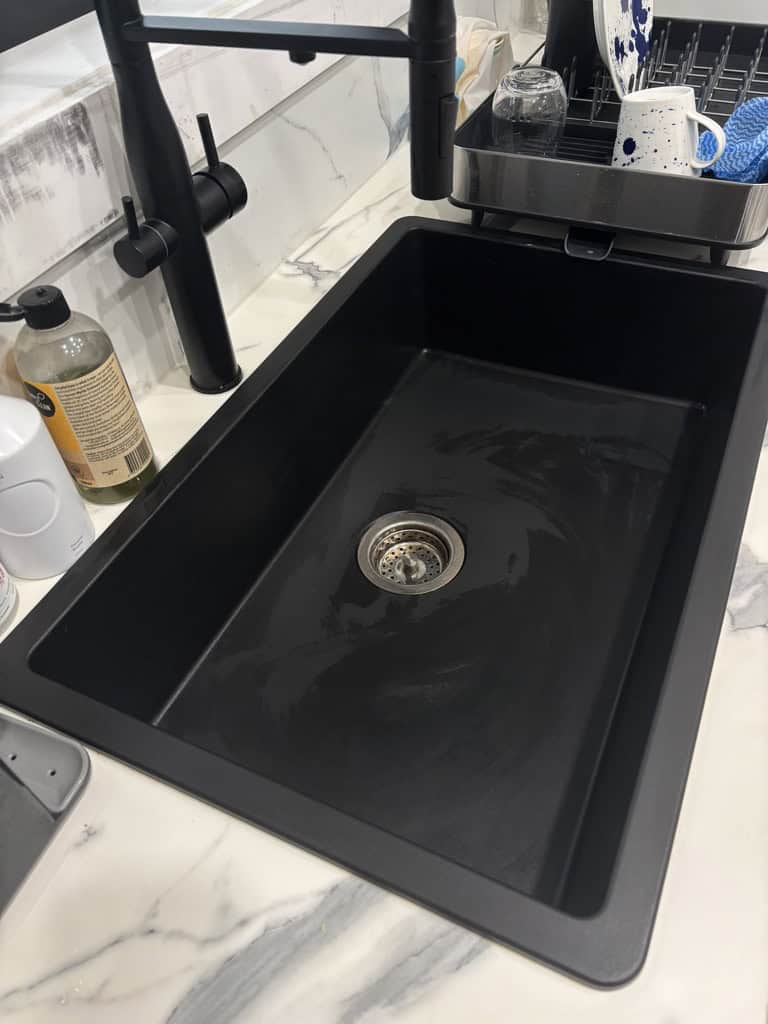
I’ve always loved black composite sinks. In our old kitchen we had these two stainless steel sinks that were so small, I could barely fit a pot in them. So when we renovated our kitchen, I instantly jumped at the opportunity to get a big, deep, black kitchen sink installed.
It’s one of those household features that makes me smile every time I walk into my kitchen. But it wasn’t long before I realized that keeping the sink surface looking pristine requires a little more love and attention than I initially thought.
There’s something about those faint white marks and streaks that feels impossible to ignore.
And let’s not even start on the dreaded mineral buildup from hard water. (It also helps to stack your dishes in the dishwasher, instead of leaving them in the sink. But that’s a story for another day…)
If you’ve been struggling to maintain that flawless finish, you’re not alone. As a mum juggling little ones, meal prep, and the constant whirlwind of life, I know firsthand how challenging it can be to add regular maintenance of anything to an already endless to-do list.
But here’s the good news: How to clean a black kitchen sink doesn’t have to be complicated or time-consuming. With the right techniques and a few simple pantry staples, you can have your black sink looking as gorgeous as the day it was installed. Best of all, we’re achieving this without daily cleaning, resorting to harsh chemicals or breaking the bank.
In this post, I’ll share how to clean a black kitchen sink with my favorite tried-and-tested methods. Whether you’re dealing with food stains, stubborn stains, or a full-on grime situation, I’ve got you covered. Here are some simple, natural cleaning solutions that are mum-approved, eco-friendly, and budget-conscious. Let’s dive in!
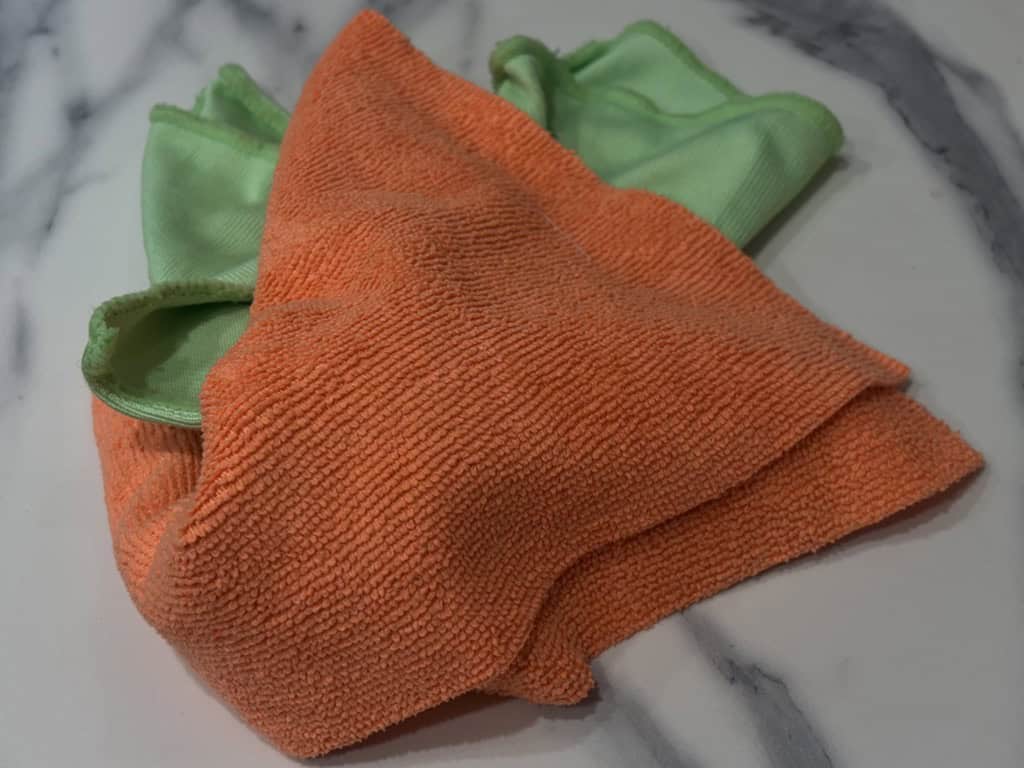
How to clean a black kitchen sink – Essential tools
To keep our black kitchen sink sparkly clean, we’ll lean on a few simple household items. Make sure your kitchen is stocked with the following supplies:
- Soft cloth or sponge. Choose a lint-free cloth to avoid any fibres being left behind. This can be a recycled clean towel or a microfibre cloth. Make sure you have a soft sponge with non-scratch qualities.
- Mild dish soap. What’s good for dirty dishes is excellent for our black sink.
- Baking soda
- White vinegar
- Lemon juice
- Olive oil or mineral oil
Tools to avoid
Harsh chemicals. We’ll be focussing on natural ways to keep your kitchen sink clean.
Abrasive cleaners. Black composite sinks are beautiful, but can be easily damaged through improper use of tools. Do not use steel wool or stiff brushes. To keep the surfaces in top condition we’ll instead be using a non-abrasive cleaner like a soft cloth or nylon brush.
Methods for how to clean a black kitchen sink
1. The Baking Soda and Vinegar Magic
Why It Works
Baking soda and vinegar are a powerhouse duo for natural deep cleaning. Baking soda gently scrubs away grime without scratching, while vinegar dissolves mineral deposits and sanitizes. Together, they create a fizzy reaction that lifts dirt and grime effortlessly.
How to Approach This Method
- Gather Supplies: Grab baking soda, white vinegar, a soft cloth, and a non-abrasive sponge.
- Prep Your Sink: Start by rinsing the sink with warm water to remove food residue.
- Sprinkle and Scrub: Sprinkle baking soda generously over the sink’s surface. Pat special attention to any stained areas. Dampen your sponge and use circular motions to scrub.
- Add Vinegar: Pour white vinegar over the baking soda. It will fizz up—this reaction helps loosen tough grime.
- Final Rinse and Dry: After a few minutes, rinse thoroughly with hot water and dry with a soft clean cloth.
Why You’ll Love This Method
It’s budget-friendly, chemical-free, and incredibly effective. The gentle abrasiveness of baking soda ensures your black sink won’t scratch, while vinegar’s natural acidity restores its shine. Plus, it’s safe for your kids and the environment—no harsh fumes or chemicals here!
Tips and Tricks
- For stubborn stains, let the baking soda and vinegar sit for 10 minutes before scrubbing.
- Use a toothbrush to reach tricky corners and around the drain.
- Always dry your sink after cleaning to prevent water spots from reappearing.
2. The Lemon and Salt Combo
Why It Works
This method is as wholesome as it gets! Lemons are naturally acidic and perfect for cutting through grime, while salt adds a gentle scrubbing action. Plus, the fresh citrus scent is a bonus.
How to Approach This Method
- Cut and Sprinkle: Slice a lemon in half and sprinkle coarse salt on the cut side.
- Scrub Away: Use the lemon as your scrubbing tool, pressing the salted side against the sink’s surface. Scrub in circular motions, paying extra attention to stains and water spots, as well as soap residue.
- Rinse and Dry: Once you’re satisfied, rinse the sink thoroughly with warm water and dry it with a soft cloth.
Why You’ll Love This Method
This approach is about as natural and simple as it gets. It’s perfect for mums who love using kitchen staples to clean (and honestly, isn’t it satisfying when you don’t have to buy special products?). Plus, it leaves your sink smelling heavenly.
Tips and Tricks
- If you don’t have fresh lemons, bottled lemon juice works in a pinch.
- After cleaning, rub a thin layer of olive oil over the sink with a paper towel to enhance its shine and create a water-resistant barrier.
- Compost the used lemon halves for a zero-waste approach.
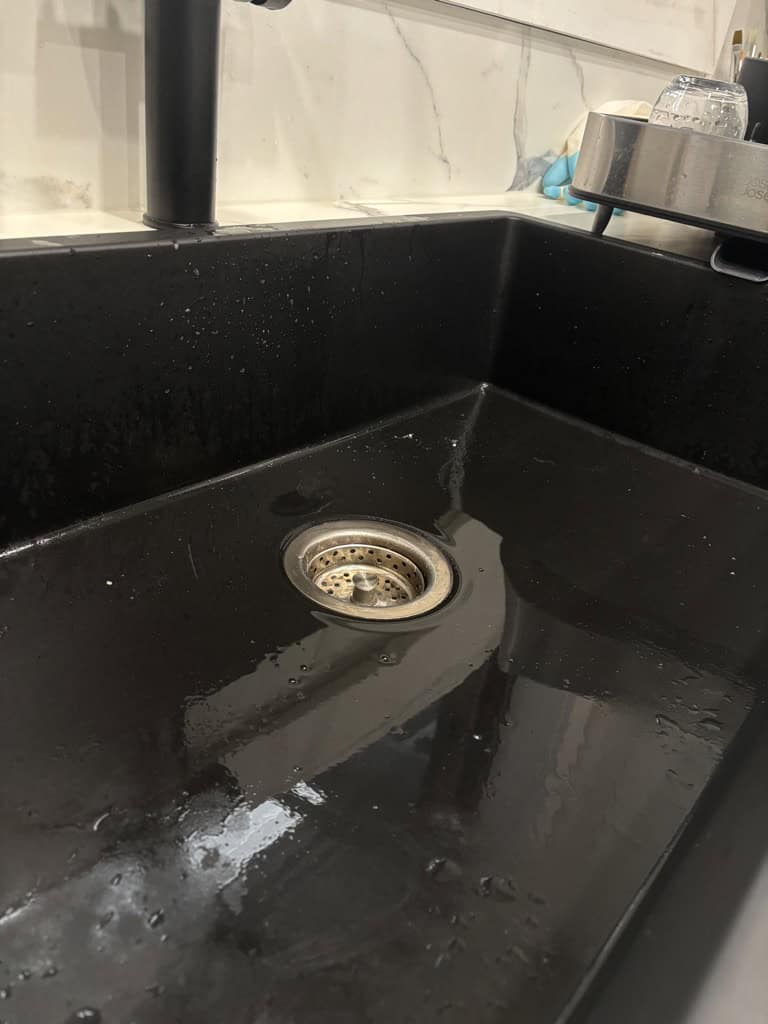
3. The Dish Soap and Vinegar Spray
Why It Works
Sometimes the simplest solutions are the best. Just like it does in regular cleaning, dish soap cuts through grease and grime, while vinegar tackles hard water stains. Together, they’re an unbeatable pair for daily maintenance.
How to Approach This Method
- Mix Your Cleaner: Combine equal parts white vinegar and warm water in a spray bottle. Add a few drops of dish soap.
- Spray and Wipe: Spray the solution generously over the sink and let it sit for a few minutes. Then, use a soft cloth to wipe the surface.
- Rinse and Buff: Rinse with warm, clean water and dry with a microfiber cloth for a streak-free finish.
Why You’ll Love This Method
This is the ultimate low-effort, high-reward cleaning hack. It’s perfect for busy mums who want a quick, effective way to keep their sinks looking great every day. The vinegar sanitizes, the dish soap lifts grime, and the combination leaves your sink sparkling.
Tips and Tricks
- Use this spray for daily wipe-downs to prevent buildup.
- For extra shine, buff the sink with a dry microfiber cloth after cleaning.
- Add a few drops of your favorite essential oil to the spray bottle for a custom scent (lavender and lemon are lovely options).
Recipes to try
Cleaning a sink is much more fun with a snack. So why not try one of these recipes? Whether you’re after something sweet like Nutella cookies, or a savoury bowl of sweet potato soup, I’ve got you covered.
Frequently Asked Questions
How often should I clean my black sink?
Sinks are best cleaned on a regular basis. For daily maintenance, a quick wipe-down with a dish soap and vinegar spray is enough. For a deeper clean, aim for once a week or whenever you notice soap buildup or water spots.
Can I use bleach on a black sink?
No, avoid using bleach or harsh chemicals. These can discolor or damage the sink’s finish over time. Stick to natural cleaners or products specifically designed for black sinks.
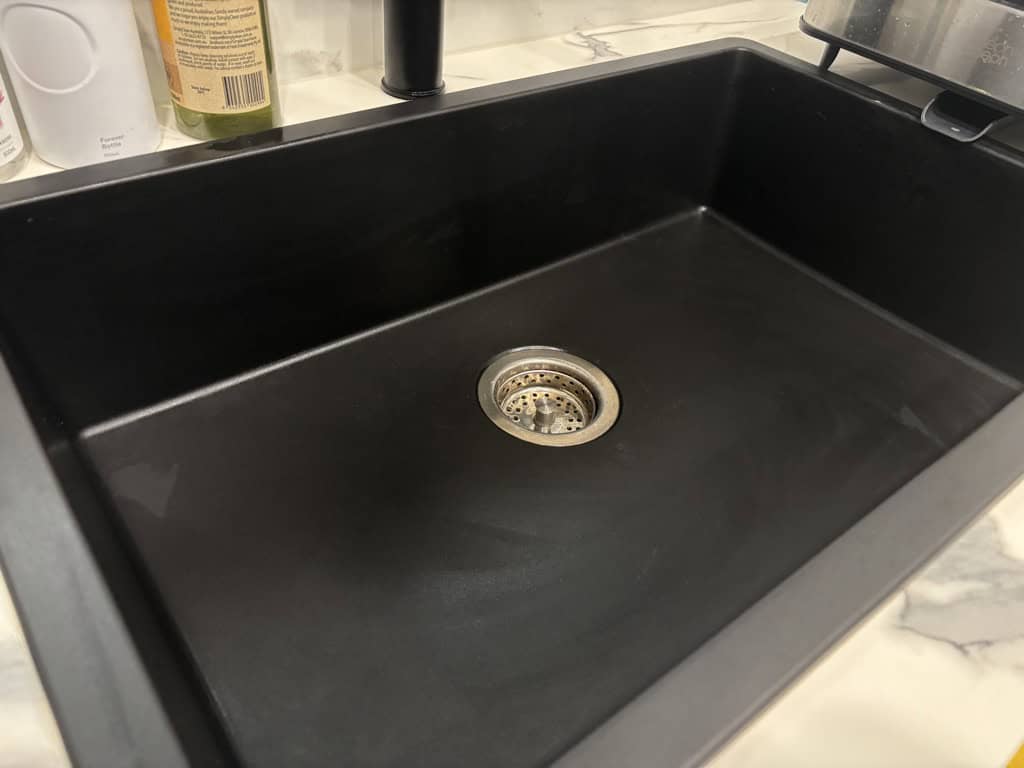
How do I prevent water spots?
Always dry your sink after each use. Hard water minerals are the main culprit behind spots, so keeping the sink dry is key.
What’s the best way to maintain the sink’s shine?
After cleaning, buff the surface with a few drops of olive oil. This not only creates a nice sink finish but also creates a protective layer that repels water.
Final Thoughts
Keeping a clean kitchen sink looking its best after daily use doesn’t have to be a chore. With these natural, effective cleaning methods, you can maintain its sleek appearance without spending a fortune or relying on harsh chemicals. Whether you prefer the fizzy magic of baking soda and vinegar, the refreshing scrub of lemon and salt, or the simplicity of a dish soap spray, there’s a method here to suit your lifestyle, one simple step at a time.
Remember, how to clean a black kitchen sink isn’t just about aesthetics—it’s about creating a wholesome, welcoming kitchen space where you can cook, clean, and make memories with your family. A little love and care go a long way, and your sink will thank you for it!
Which method will you try first? Let me know in the comments below, and share any of your own tips for keeping a black sink spotless. Happy cleaning!


